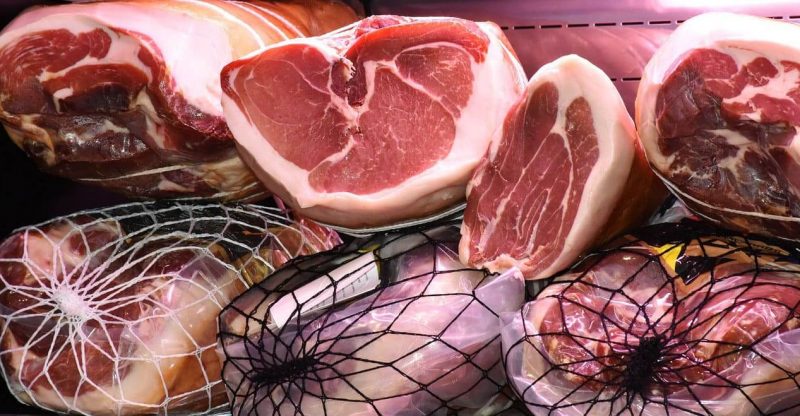What is Erythorbic Acid (E315) in Food: Uses in Meat, Safety, Side effects

Production | Uses | Safety | Side effects | FAQs
Since the FDA banned the use of sulfites as a preservative on raw fruits and vegetables from 1986 (1), the use of erythorbic acid has increased. It is a stereoisomer of ascorbic acid (vitamin C), can be used as an antioxidant, a preservative and a color stabilizer in processed meat and fish products with the European food additive number E315.
Its antioxidative mechanism (same with sodium erythorbate and ascorbic acid) is as an oxygen scavenger that reacts with oxygen to reduce the oxygen content in food.
While another common type antioxidants (butylated hydroxyanisole, Butylated hydroxytoluene, and TBHQ), functions through inhibiting free radical autoxidation by providing hydrogen free radicals.
How is Erythorbic Acid made?
It can be produced by a reaction between methyl 2-keto-D-gluconate and sulphuric acid.
Generally, the manufacturing process has 5 steps:
- Producing calcium 2-keto-D-gluconate: food-grade starch hydrolysate fermentation by Pseudomonas fluorescens with calcium carbonate.
- Acidify the above fermentation broth to obtain 2-keto-D-gluconic acid (2-KG).
- Esterification 2-KG with methanol under acid conditions to yield methyl 2-keto-D-gluconate.
- The synthesis of sodium erythorbate: heating the above suspension with sodium bicarbonate or sodium carbonate.
- The reaction between sodium erythorbate and sulphuric acid.
Structure

Image Source
Properties
| Appearance | White to slightly yellow crystalline solid which darkens gradually on exposure to light. |
| Other names | D-Isoascorbic acid; D-Araboascorbic acid |
| CAS number | 89-65-6 |
| Chemical formula | C6H8O6 |
| Molecular weight | 176.13 |
| PKa | It is a diprotic acid having pKa’s 11.34 and 4.04. |
| Solubility |
|
What’s The Application Of Erythorbic Acid?
Generally, it is widely used to stabilize color, reduce nitrate uses, and prevent oxidation in meat products, fruits and vegetables. And therefore maintain the color & flavor and extend their shelf life. Meanwhile, it benefits our body through reducing nitrosamine formation which is generated by the intake of nitrate.
Food
Its main uses are in meat products, fruits & vegetables and also in soft drinks & beer.
Meat products
Cured and preserved meat products takes an important part in the meat industry.
Provide a bright red color
In order to achieve the purpose of preserving meat products and produce a bright red color, the traditional method is to add nitrate which can interact with amines in the human body to form a carcinogen nitrosamine, which is harmful to our health.
Reduce nitrosamines
It can significantly reduce the production of nitrosamines if the combination uses of erythorbic acid with nitrite.
At the same time, it can stabilize the color of meat.
It was reported by Mintel GNDP that nearly 5,000 products out of nearly 1 million products sold in Europe contain erythorbic acid or sodium erythorbate in meat products or products contained meat as an ingredient (e.g. pizza, ready-to-eat meat meals, meat-based spread and filled pasta).
Fruits and Vegetable Processing
Fresh fruit and vegetable products can easily cause quality problems during the preservation, such as microbial growth, softening, weightlessness and browning due to cracks.
The traditional browning inhibitor is sulfur, but it can cause several health problems such as high blood pressure.
Erythorbic acid or sodium erythorbate can be used to keep the freshness and stabilize the color of fruit and vegetables by soaking or spraying its solution on the surface.
Drink and Beer
Erythorbic acid and its sodium salt can be used as an antioxidant in beverages, beer and etc.
It can eliminate the discoloration, odor and turbidity, and improve the poor taste of beverages. In beer, it can remove the stale odor, enhance flavor stability, and prolong its shelf life.
Cosmetics
Per the “European Commission database for information on cosmetic substances and ingredients”, it functions as an antioxidant in cosmetic and personal care products. (2)
It can be found in hair and nail products.
Is Erythorbic Acid Safe to Eat?
Yes, its safety used as a food additive has been approved by the U.S. Food and Drug Administration (FDA), European Food Safety Authority (EFSA), Joint FAO/WHO Expert Committee on Food Additives (JECFA), as well as other authorities.
FDA
It is generally recognized as safe (GRAS) when used in accordance with good manufacturing practices in food and feed. (3) (4)
It can be used as an antimicrobial agent, antioxidant, color or coloring adjunct, curing or pickling agent, flavor enhancer, flavoring agent or adjuvant. (5)
EFSA
Erythorbic acid (E 315) is listed in Commission Regulation (EU) No 231/2012 as an authorised food additive in the EU as “Additives other than colours and sweeteners”. (6)
Safety re-evaluation in 2016
After the studies of genotoxicity and carcinogenicity and others, EFSA claimed “there is no reason to revise the current ADI of 6 mg/kg bw/day and the use of erythorbic acid (E 315) and sodium erythorbate (E 316) as food additives at the permitted or reported use and use levels would not be of safety concern.” (7)
Authorised Uses
The following foods may contain it (8):
- Cured and preserved meat products
- Frozen and deep-frozen fish with red skin
- Preserved and semi-preserved fish products
Food Standards Australia New Zealand
It is an approved ingredient in Australia and New Zealand with the code number 315. (9)
JECFA
Food grade Specification, function class: Antioxidant. (10)
Acceptable Daily Intake: ADI “not specific” set in 1990. (11)
What are the possible Side Effects?
It is common that sometimes consumers have questions whether erythorbic acid is bad for our health and what are the side effects in the food we eat. However, it is generally considered safe and almost no reported health risks. Maybe some people are allergic or sensitive to it.
Frequently asked questions
Is it Natural?
No, we can know it is synthetic from the manufacturing process mentioned above.
Is it Halal?
Yes, it is recognised as halal as it is permitted under the Islamic Law and fulfill the conditions of Halal. And we can find some manufacturers certificated with MUI halal.
Is it Kosher?
Yes, it is kosher pareve. It has met all the “kashruth” requirements and can be certified as kosher or maybe kosher passover.
Is it Gluten free?
Yes, it is gluten free according to FDA that it does not contain wheat, rye, barley, or crossbreeds of these grains.
Is it Vegan?
Generally, it is vegan as the manufacturing process without the use of animal matter or products derived from animal origin. So it is considered vegan and vegetarians can eat the food with it.
Is it dairy free?
Yes.
What’s the Relationship with Ascorbic Acid?
It is a stereoisomer of ascorbic acid.
Erythorbic Acid vs Sodium Erythorbate?
The latter is more stable and is used widely in meat than the former.
Conclusion
Erythorbic acid (E315) and its sodium salt paly an important role in the meat industry, what kind of meat do you find this antioxidant in? Let me know in the comment.



Interested about erythorbic acid usage for beverages, specially its function for antioxidants
may be you can share some regulation about it.
thank you
Regards,
Victor Trisna